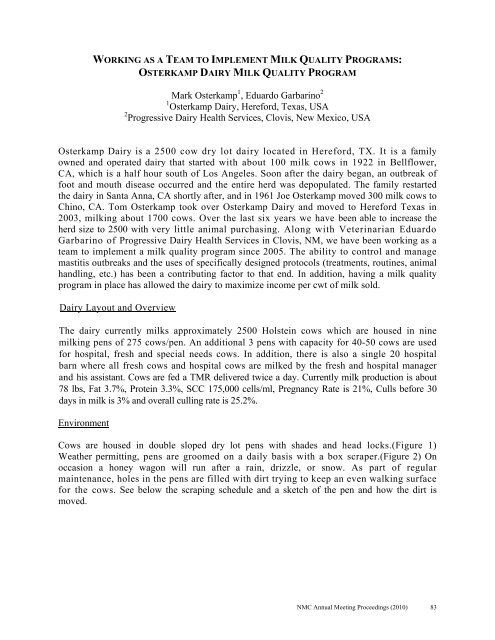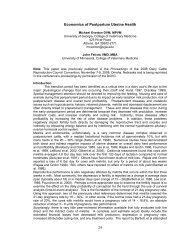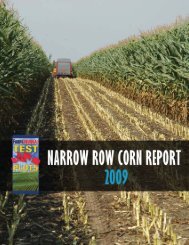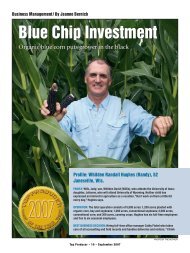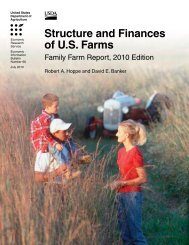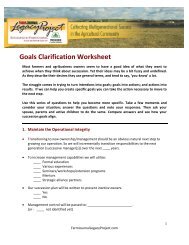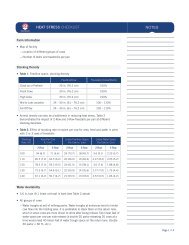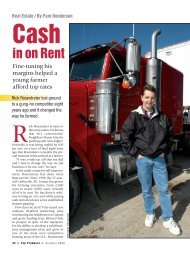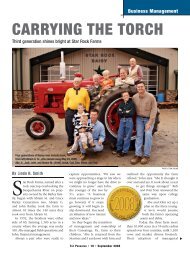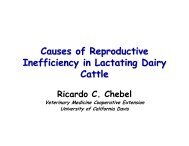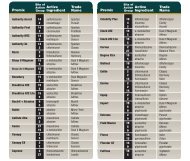osterkamp dairy milk quality program - AgWeb
osterkamp dairy milk quality program - AgWeb
osterkamp dairy milk quality program - AgWeb
Create successful ePaper yourself
Turn your PDF publications into a flip-book with our unique Google optimized e-Paper software.
WORKING AS A TEAM TO IMPLEMENT MILK QUALITY PROGRAMS:<br />
OSTERKAMP DAIRY MILK QUALITY PROGRAM<br />
Mark Osterkamp 1 , Eduardo Garbarino 2<br />
1 Osterkamp Dairy, Hereford, Texas, USA<br />
2 Progressive Dairy Health Services, Clovis, New Mexico, USA<br />
Osterkamp Dairy is a 2500 cow dry lot <strong>dairy</strong> located in Hereford, TX. It is a family<br />
owned and operated <strong>dairy</strong> that started with about 100 <strong>milk</strong> cows in 1922 in Bellflower,<br />
CA, which is a half hour south of Los Angeles. Soon after the <strong>dairy</strong> began, an outbreak of<br />
foot and mouth disease occurred and the entire herd was depopulated. The family restarted<br />
the <strong>dairy</strong> in Santa Anna, CA shortly after, and in 1961 Joe Osterkamp moved 300 <strong>milk</strong> cows to<br />
Chino, CA. Tom Osterkamp took over Osterkamp Dairy and moved to Hereford Texas in<br />
2003, <strong>milk</strong>ing about 1700 cows. Over the last six years we have been able to increase the<br />
herd size to 2500 with very little animal purchasing. Along with Veterinarian Eduardo<br />
Garbarino of Progressive Dairy Health Services in Clovis, NM, we have been working as a<br />
team to implement a <strong>milk</strong> <strong>quality</strong> <strong>program</strong> since 2005. The ability to control and manage<br />
mastitis outbreaks and the uses of specifically designed protocols (treatments, routines, animal<br />
handling, etc.) has been a contributing factor to that end. In addition, having a <strong>milk</strong> <strong>quality</strong><br />
<strong>program</strong> in place has allowed the <strong>dairy</strong> to maximize income per cwt of <strong>milk</strong> sold.<br />
Dairy Layout and Overview<br />
The <strong>dairy</strong> currently <strong>milk</strong>s approximately 2500 Holstein cows which are housed in nine<br />
<strong>milk</strong>ing pens of 275 cows/pen. An additional 3 pens with capacity for 40-50 cows are used<br />
for hospital, fresh and special needs cows. In addition, there is also a single 20 hospital<br />
barn where all fresh cows and hospital cows are <strong>milk</strong>ed by the fresh and hospital manager<br />
and his assistant. Cows are fed a TMR delivered twice a day. Currently <strong>milk</strong> production is about<br />
78 lbs, Fat 3.7%, Protein 3.3%, SCC 175,000 cells/ml, Pregnancy Rate is 21%, Culls before 30<br />
days in <strong>milk</strong> is 3% and overall culling rate is 25.2%.<br />
Environment<br />
Cows are housed in double sloped dry lot pens with shades and head locks.(Figure 1)<br />
Weather permitting, pens are groomed on a daily basis with a box scraper.(Figure 2) On<br />
occasion a honey wagon will run after a rain, drizzle, or snow. As part of regular<br />
maintenance, holes in the pens are filled with dirt trying to keep an even walking surface<br />
for the cows. See below the scraping schedule and a sketch of the pen and how the dirt is<br />
moved.<br />
NMC Annual Meeting Proceedings (2010)<br />
83
Pen layout example. Figure 1.<br />
cement<br />
water water water<br />
dry manure for bedding 1/2 to 1 in.<br />
Shade is also included<br />
shade<br />
wet manure for drying 1/2 to 1 in.<br />
Scraping schedule. Figure 2.<br />
Mon. Tues. Wed. Thurs. Fri. Sat. Sun.<br />
Valentin (Day) Milk xxxxxxxx Milk p8 - p15 Milk xxxxxxxx xxxxxxxx<br />
p1 - p5 All Pens Hef All Pens<br />
p8 - p15<br />
Dry<br />
Hugo (Night) Milk xxxxxxxx Milk xxxxxxxx xxxxxxxx Milk Milk<br />
p6 - p7 p1 - p4 p1 - p4 p23 - p7<br />
Milking Equipment<br />
The <strong>milk</strong>ing equipment consists of standard stainless steel DeLaval claws with Milk Right<br />
shells and liners. Universal pulsators with pulsation rate set at 60:40 are used. Universal<br />
automatic take-off settings are described in figure 3. The vacuum is set at 12.75 "Hg at the<br />
teat end.<br />
84 NMC Annual Meeting Proceedings (2010)
Take-off settings. Figure 3.<br />
Milk Flow<br />
Lb/Min.<br />
Threshold 0.41<br />
Take-off<br />
Sec.<br />
Time 30<br />
Neutral<br />
Sec.<br />
Time 125<br />
EV Delay<br />
Sec.<br />
Time 2.5<br />
Milking Routine and Milker Meetings<br />
Milking routine<br />
Cows are <strong>milk</strong>ed twice a day in a double 35, parallel parlor. The <strong>milk</strong>ing routine is a complete<br />
routine under a territorial arrangement. Milker #1 pre-dips from cow #1 to cow #13 then goes<br />
back to cow #1 and strips to cow #13, walks back wiping from #13 to #1 and finally hangs<br />
machines from #1 to #13. See graph 1. Milker #2 does the same routine from cow #14 to cow<br />
#24 and <strong>milk</strong>er #3 repeats the same steps from cow #25 to cow #35. Milker #3 has fewer<br />
machines because he is in charge of filling the line when the pusher is not in the pit. One pusher<br />
completes the team and his responsibilities include: prepping the cloth towels, filling the post dip<br />
cups, helps filling the lane, and bringing the pens to the barn. The pusher does not help in the<br />
<strong>milk</strong>ing routine other than the post dipping process.<br />
NMC Annual Meeting Proceedings (2010)<br />
85
Milking routine. Figure 4.<br />
Milkers are evaluated once a month for routine compliance. This is done by the <strong>dairy</strong> manager<br />
using a standardized evaluation form. (Figure 5) The goals of the evaluations are to detect areas<br />
that need improvement in the routine, determine if the <strong>milk</strong>ers are entitled to receive the <strong>quality</strong><br />
bonus offered by the <strong>dairy</strong>, and document as well as discuss areas of improvement. Results of the<br />
evaluation are used as a basis for the subsequent <strong>milk</strong>er meeting. In addition, the <strong>milk</strong>ers need to<br />
have a satisfactory evaluation in order to receive the <strong>milk</strong> <strong>quality</strong> bonus.<br />
As an aid to stimulate parlor consistency for all the <strong>milk</strong>ers, the manager keeps track of how<br />
many cows are pulled for mastitis by each <strong>milk</strong>er. This information is posted for the <strong>milk</strong>ers to<br />
see and allows management to detect differences among employees in the parlor. If large<br />
differences exist among <strong>milk</strong>ers, they are addressed in the meetings or with the particular<br />
individual. Since we initiated this protocol, large fluctuations in bulk tank somatic cells have<br />
drastically been reduced.<br />
Milker meetings<br />
Every 3 months a 1 hour <strong>milk</strong>er meeting is scheduled with each shift (day/night). In each<br />
meeting, <strong>milk</strong> <strong>quality</strong> information (SPC, LPC, Coli and SCC) is presented for the last year to<br />
date and the previous month. The aim is to teach the <strong>milk</strong>ers how to interpret the information<br />
presented (graphs, tables, etc.) from a learning perspective and for improvement on the job. In<br />
addition, the <strong>milk</strong>ers are educated regarding the current <strong>milk</strong> <strong>quality</strong> bonus standards set by the<br />
Co-op. In order for the <strong>dairy</strong> to receive a bonus, 25% of the <strong>milk</strong> loads are tested, in which 75%<br />
of them need to be below the Co-op thresholds (SPC
addition the veterinary practice provides a <strong>milk</strong>er meeting school for all new <strong>milk</strong>ers. In this<br />
meeting we explain the <strong>milk</strong>ing routine step by step and a thorough understanding of the<br />
importance of cleanliness and consistency in the parlor. An explanation of what the <strong>dairy</strong> expects<br />
from the <strong>milk</strong>er and what the <strong>milk</strong>er should expect from the <strong>dairy</strong> is also covered. The idea is to<br />
present rules and expectations clearly and upfront with the hope that by good communication we<br />
will achieve better compliance.<br />
NMC Annual Meeting Proceedings (2010)<br />
87
Evaluation form. Figure 5.<br />
Osterkamp Dairy - Milker Evaluation<br />
Date: ____________________________<br />
Milkers Name:________________________<br />
Shift: ___________________<br />
Cow Handling V.Good Good Needs Improvement Poor Quiet with no aggressions<br />
Pre-Dip: V.Good Good Needs Improvement Poor All 4 teats completely<br />
Strip: V.Good Good Needs Improvement Poor 2-3 squirts per teat<br />
Wipe: V.Good Good Needs Improvement Poor Circular motion. Are teats clean after wipping?<br />
Timming: V.Good Good Needs Improvement Poor Time between Pre-Dip and Wipe >30 sec<br />
time between Strip and Attach 1-2min<br />
Attach: V.Good Good Needs Improvement Poor Are units align and no air allowed when attaching<br />
Re-Attach V.Good Good Needs Improvement Poor Is the <strong>milk</strong>er looking for squaks and unaligned units?<br />
Detach: V.Good Good Needs Improvement Poor Is the vacuum shut off before detaching?<br />
Post-Dip: V.Good Good Needs Improvement Poor All 4 teats completely<br />
Comments:<br />
Evaluator: _________________________ Milker Signatu__________________________<br />
Action plan for non-compliance: Each person will receive a warning if evaluation is Poor in one<br />
or more items. At the first warning the manager will address the problem with the <strong>milk</strong>er.<br />
After the second warning, the <strong>milk</strong>er looses the monthly bonus.<br />
After 3 warnings a person could be fired.<br />
88 NMC Annual Meeting Proceedings (2010)
Mastitis Control and Treatment<br />
All <strong>milk</strong> from fresh and mastitic cows is sampled and plated on blood agar and mycoplasma<br />
media. All mastitis cases are treated with a standard intramammary antimicrobial. Cows with<br />
hard quarters are also treated with an intramammary antimicrobial and an anti-inflammatory.<br />
Cows that appear to be sick are given systemic therapy, rumen drench, and intravenous fluid<br />
therapy in addition to an intramammary antimicrobial and an anti-inflammatory.<br />
Dry Cow Management<br />
All cows receive a standard dry cow tube shortly after their last <strong>milk</strong>ing on each teat. Cows are<br />
dipped with the same barrier dip used on the <strong>milk</strong> cows and moved to the dry pen. Cows are dry<br />
for 60 days.<br />
Culling Policy<br />
Cows are evaluated on an individual basis before treatment. Items like days in <strong>milk</strong>, <strong>milk</strong><br />
production at last test, times with mastitis, reproductive status (open/pregnant), other health<br />
issues (lameness) are taken into consideration to decide the future of each cow.<br />
Summary<br />
Communication between the <strong>dairy</strong> and the <strong>milk</strong>ers is the key for successfully implementing a<br />
<strong>milk</strong> <strong>quality</strong> <strong>program</strong>. Monitoring <strong>milk</strong>ers for positive and/or negative reinforcement is an<br />
important part of motivating employees. As a result of working as a team between the <strong>dairy</strong><br />
manager, veterinarian and <strong>milk</strong>ers, Osterkamp Dairy has achieved all but one (52/53) <strong>milk</strong><br />
<strong>quality</strong> bonuses from June 2005 up to November 2009. Additionally and harder to quantify,<br />
somatic cells has been consistently lower than at the start of the <strong>program</strong>, udder health has<br />
improved, and culling due to mastitis has been reduced.<br />
NMC Annual Meeting Proceedings (2010)<br />
89


